A look at how the garden suburb Bedford Park has changed since 1882
1. View from Newton Grove, Bedford Park 1882
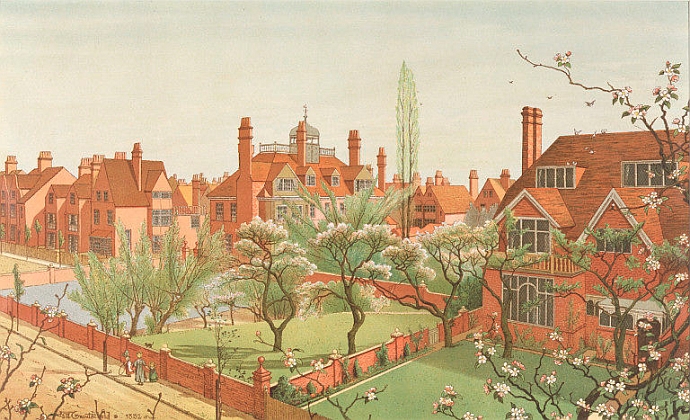 Tower House and Queen Anne's Grove 1882 by Manfred Trautschold (1854-1921)
Tower House and Queen Anne's Grove 1882 by Manfred Trautschold (1854-1921)
Unfortunately, Tower House, the large house in the centre of Trautschold's beautiful painting, has gone. The house on the right has also gone. The replacement for those houses is shown below in a view from above Newton Grove :
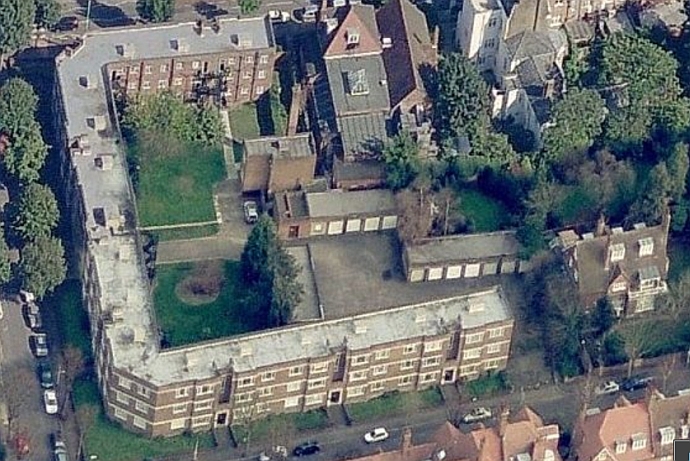 Tower House was demolished and replaced by St Catherine's Court in the 1930s.
Tower House was demolished and replaced by St Catherine's Court in the 1930s.
Those flats look nice inside and the flat owners have views of very attractive Queen Anne style houses. Unfortunately, the view is not so nice the other way around. The fact that the owner of one of those houses on Newton Grove facing those horrible garages was an expert in Victorian architecture must have made that view even more unpleasant. He started a campaign to block further developments and thanks to his efforts and the efforts of other members of the Bedford Park Society 356 houses in Bedford Park have been Grade II listed.
2. View in Newton Grove, Bedford Park 1882
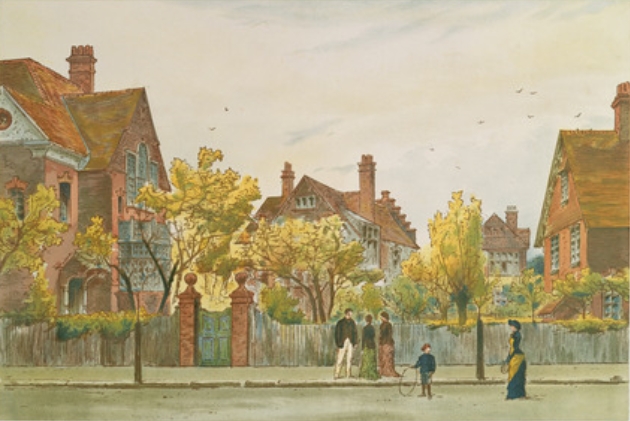
14 Newton Grove 1882 by Joseph Nash Jr (1835-1922)
All the houses above are still there but because of infill they are not easily recognisable. The house on the left, 14 Newton Grove, was built as a semi-detached - that can be seen below left - and now it is part of a terrace. The house with the crenelated gable is in Orchard Road.

A view of 12 and 14 Newton Grove in 1882 compared with the same view in 2016
3. The Avenue looking South, Bedford Park 1882
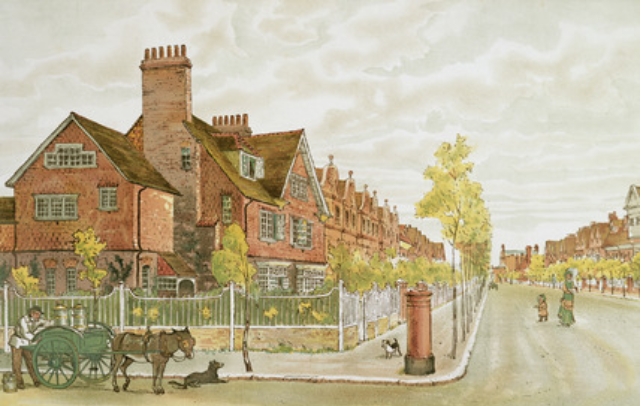
36 The Avenue, Bedford Park 1882 by John Charles Dollman (1851-1934)
This view remains unchanged. Joseph Nash Jr lived at 36 The Avenue and J.C. Dollman lived at 14 Newton Grove, the house painted by Nash.
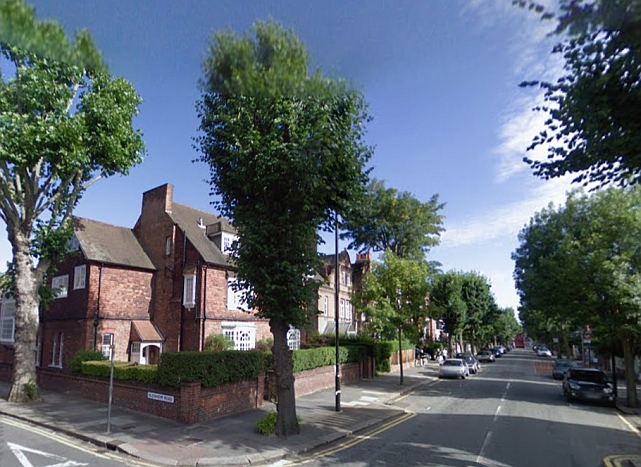
36 The Avenue, Bedford Park 2016
4. Queen Anne Gardens, looking north 1882
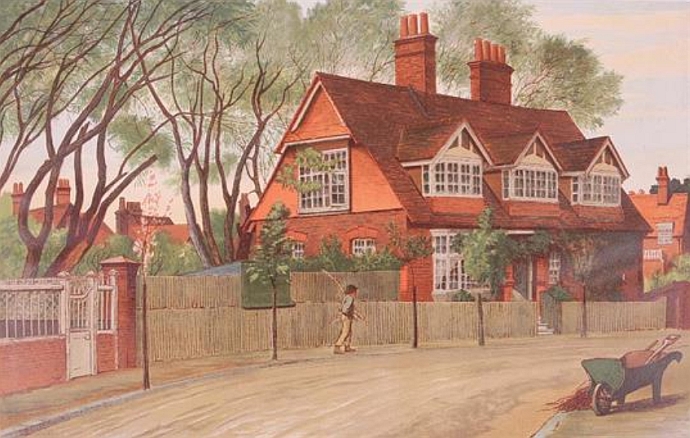
7 Queen Anne Gardens 1882 by Henry Marriott Paget (1856–1936)
This very attractive house looks unchanged. Thomas Matthews Rooke lived here in 1882. Paget lived at Milton Lodge, The Avenue.
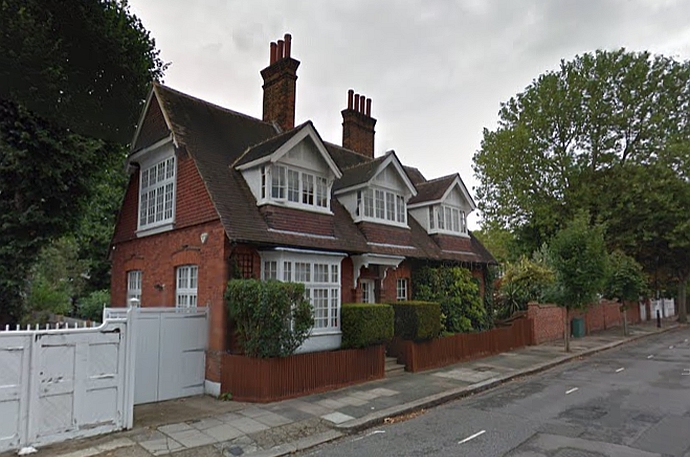
7 Queen Anne Gardens 2016
5. Back of Tabard Inn and Church, from Railway Station 1882
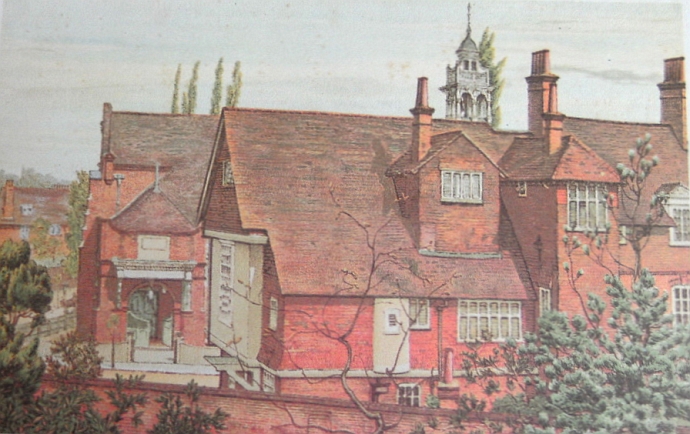 Back of Tabard Inn and Church by Thomas Matthews Rooke (1842–1942)
Back of Tabard Inn and Church by Thomas Matthews Rooke (1842–1942)
There is now a large modern building at the back of the Tabard Inn blocking that view from Turnham Green Station.
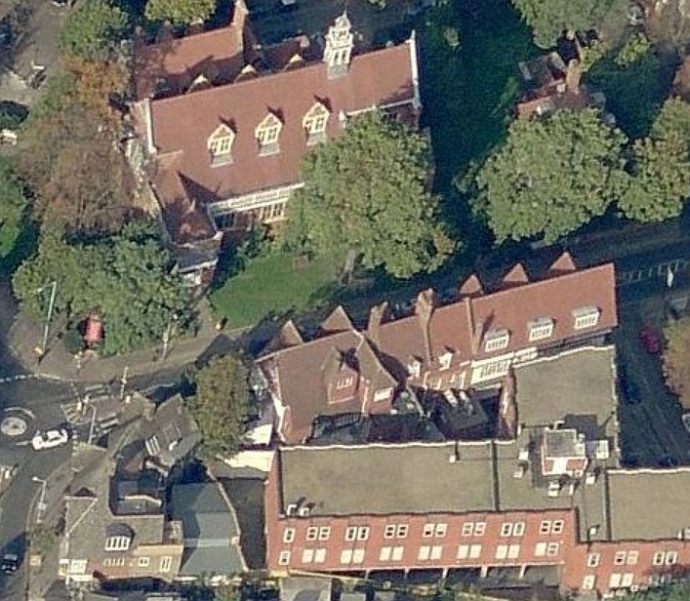 Back of Tabard Inn and Church 2016
Back of Tabard Inn and Church 2016
6. School of Art, stores and Tabard Inn, looking west 1882
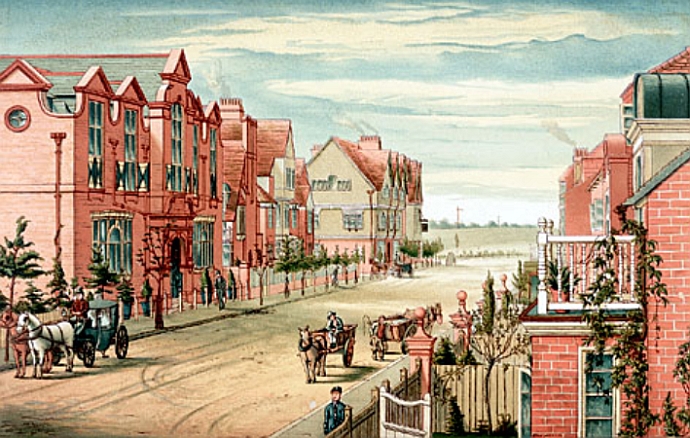
School of Art, stores and Tabard Inn, looking west by Thomas Erat Harrison (1858-1917)
The white balustrade is gone but house on the right is probably 1 Rupert Road, which is the attractive house below next to the Rupert Road sign below.
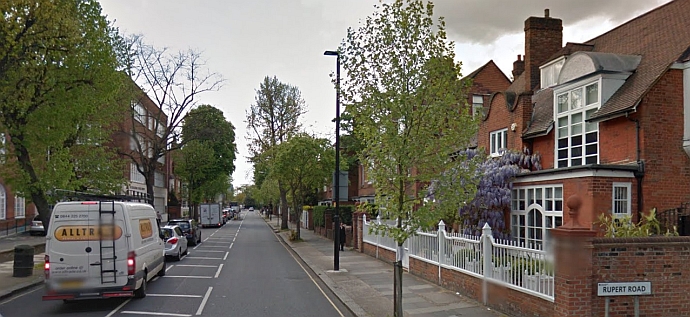
View of School of Art, Bath Road looking west 2016
The original Chiswick School of Arts and Crafts was destroyed in 1944 by a V1, but the part of the replacement art school which extends out to road stands on the same spot as the original school. The view to the stores and the Tabard Inn is blocked by trees but they remain more or less as they were in the picture. The open land at the end of Bath Road is still there. Thomas Erat Harrison lived at 3 Bath Road which is directly opposite the art school.
7. Bath Road, looking east 1882
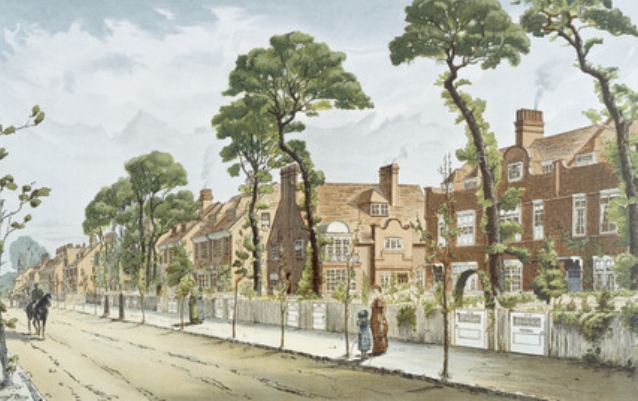
Bath Road, looking east by Berry F. Berry (1852-1926)
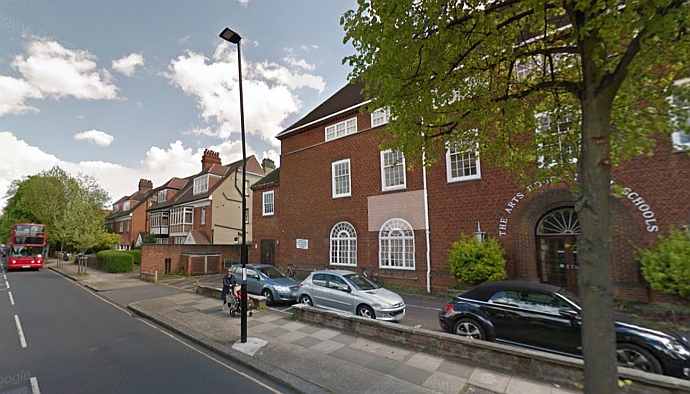
Bath Road, looking east 2016
The Bath Road looking east painting was done at the same position as the Bath Road looking west painting. Perhaps Berry and Harrison set up their easels next to each other. The houses up to and including the large detached house have been replaced by the new art school. They were probably badly damaged by the 1944 V1.
8. St Michael & All Angels Bedford Park 1882
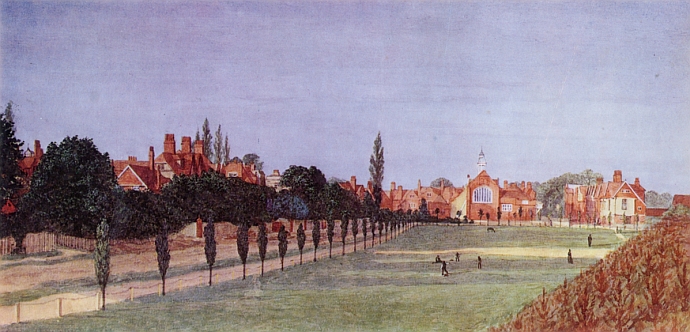 St Michael & All Angels Bedford Park by Frederick Hamilton Jackson (1848-1923)
St Michael & All Angels Bedford Park by Frederick Hamilton Jackson (1848-1923)
Most of the houses and the green remain unchanged. The painting was probably done on the railway embankment.
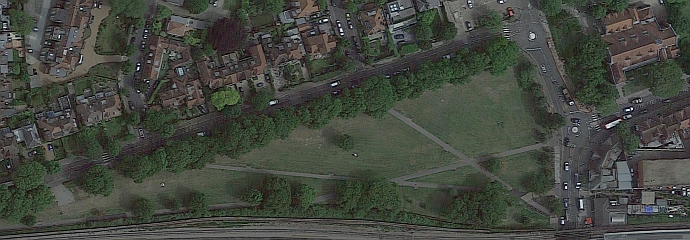 St Michael & All Angels (top right) 2016
St Michael & All Angels (top right) 2016
9. The church, Tabard Inn and stores, from Acton Green 1882
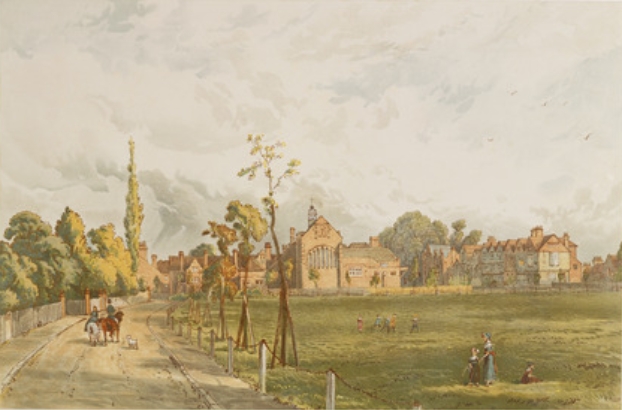
The church, Tabard Inn and stores from Acton Green by Edward Hargitt (1835 – 1895)
Apart from the height of the trees this view remains unchanged.
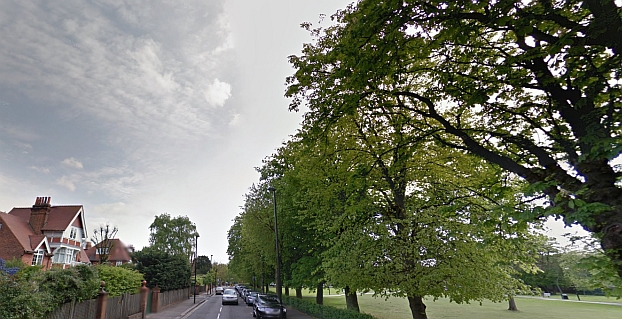
South Parade looking towards St Michael and All Angels 2016
A view of Bath Road, Bedford Park by Camille Pissarro
Pissarro was in a different league to the British painters above, yet his Bedford Park paintings are not, in my opinion, anything special. I like the following unfinished picture of Bath Road looking west from his house at 62 Bath Road. This was painted in 1897.
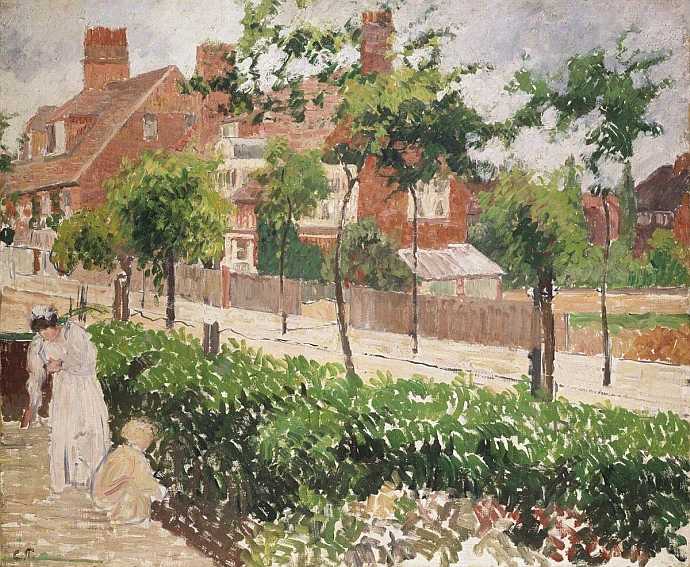 Bath Road, Bedford Park by Camille Pissarro (1830–1903)
Bath Road, Bedford Park by Camille Pissarro (1830–1903)
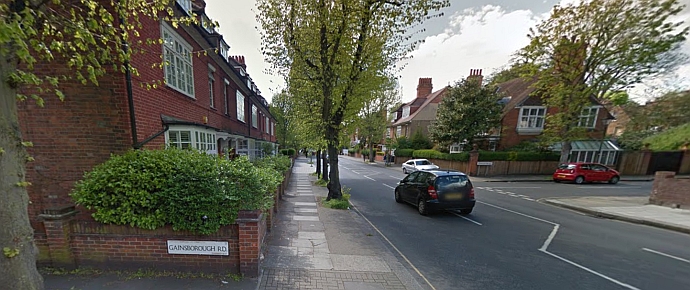 View from 62 Bath Road (first house on left) 2016
View from 62 Bath Road (first house on left) 2016
The fact that the conservatory at the side of the house across the road is still there 123 years after Pissarro painted it exemplifies, for me, the specialness of Bedford Park. This place is the antithesis of Croydon. In the 1960s Bedford Park fought the developers, but Croydon welcomed them and it was destroyed. It is strange that one of the most attractive part of Croydon was also called Bedford Park. Everything built in Croydon's Bedford Park before the 1960s has been demolished.
"The Fantastic Suburb"
This is GK Chesterton's description of Bedford Park in the opening of The Man Who Was Thursday (1908). (Saffron Park is Bedford Park.)
The suburb of Saffron Park lay on the sunset side of London, as red and ragged as a cloud of sunset. It was built of a bright brick throughout; its sky-line was fantastic, and even its ground plan was wild. It had been the outburst of a speculative builder, faintly tinged with art, who called its architecture sometimes Elizabethan and sometimes Queen Anne, apparently under the impression that the two sovereigns were identical. It was described with some justice as an artistic colony, though it never in any definable way produced any art. But although its pretensions to be an intellectual centre were a little vague, its pretensions to be a pleasant place were quite indisputable. The stranger who looked for the first time at the quaint red houses could only think how very oddly shaped the people must be who could fit in to them. Nor when he met the people was he disappointed in this respect. The place was not only pleasant, but perfect, if once he could regard it not as a deception but rather as a dream. Even if the people were not "artists," the whole was nevertheless artistic.
Chesterton was, of course, joking when he said the artists of Bedford Park had not produced any art. In 1882 nine of them painted street views for a book entitled Bedford Park. This page shows those watercolours contrasted with the same view in 2016. I have done the same with some of Camille Pissarro's Bath Road paintings.
Sergey Stepnyak-Kravchinsky (1851-1895)
Chesterton's book was about pretend anarchists but Bedford Park was home to at least one real and very dangerous anarchist. In 1878 Sergey Stepnyak-Kravchinsky had stabbed to death the head of the Russian police. After fleeing Russian and he eventually settled in Bedford Park where he seemed to spend his time plotting the downfall of the Tsar. He even wrote a novel in English about an attempt to assassinate him. His hero narrowly fails and is executed but Stepnyak seemed to think his hero had not perished in vain :
The Career of a Nihilist: A Novel 1889
He had perished. But the work for which he died did not perish. It goes forward from defeat to defeat towards the final victory, which in this sad world of ours cannot be obtained save by the sufferings and the sacrifice of the chosen few.
It is a bit like the idea the ending of Yeats's Easter 1916 poem where revolutionary sacrifice also seems to be justified. W.B. Yeats and Stepnyak both lived in Woodstock Road though not at the same time. Stepnyak lived at 31 Blandford Road from 1893 to 1895 and in 1895 he moved to 48 Woodstock Road.
George Bernard Shaw, Karl Marx, Engels and William Morris were all friends of Stepnyak. He helped Shaw with Arms And The Man and Marx's daughter Eleanor tidied up Stepnyak's English in The Career of a Nihilist.
On the 23 December 1895 Stepnyak was crossing the railway line at Woodstock Road when he was killed by a slow moving train. He was on his way to a conference of fellow Russian revolutionaries. No doubt, as he crossed the railway line, he was so preoccupied with plans to kill enemies far off in Russian that he didn't notice his own death was close at hand. Stepnyak's widow, Fanny, received a pension from the Soviets until her death in 1945.
The Yeats family
In his autobiography Chesterton mentions midnight walks from his future wife's home at 8 Bath Road, Bedford Park to his home in Kensington. He would have known all the Bedford Park artists and writers, but the Yeats family were the ones who impressed him most. They lived at 8 Woodstock Road from from 1876 to 1881 and at 3 Blenheim Road from 1888 to 1902. This is how Chesterton described the conversation of W.B.Yeats and his brother and sisters in his autobiography :
The intensity and individualism of genius itself could never wash out of the world's memories the general impression of Willie and Lily and Lolly and Jack; names cast backwards and forwards in a unique sort of comedy of Irish wit, gossip, satire, family quarrels and family pride.
He described W.B Yeats as
"The best talker I have ever met, except his old father ... A long and elaborately balanced sentence, with dependant clauses dependant or antithetical, would flow out of such talkers with every word falling into its place, quite as immediately and innocently as most people would say it was a fine day... That style, or swift construction of a complicated sentence, was the sign of a lucidity now largely lost."
W.B.Yeats, himself, in his autobiography, wrote that his friend Oscar Wilde was
...the greatest talker of his time, and his plays and dialogues have what merit they possess from being now an imitation, now a record, of his talk.
My first meeting with Oscar Wilde was an astonishment. I never before heard a man talking with perfect sentences, as if he had written them all over night with labour and yet all spontaneous. There was present that night at Henley’s, by right of propinquity or of accident, a man full of the secret spite of dullness, who interrupted from time to time, and always to check or disorder thought; and I noticed with what mastery he was foiled and thrown. I noticed, too, that the impression of artificiality that I think all Wilde’s listeners have recorded came from the perfect rounding of the sentences and from the deliberation that made it possible.
The Henley mentioned above was William Ernest Henley, the author of "Invictus". He lived at 1 Merton Place, Chiswick High Road. Henley was the model for Robert Louis Stevenson's Long John Silver. The National Biography mentions his "wild flood and storm of talk". Oscar Wilde said "To converse with him is a physical no less than an intellectual recreation." Henley's soirees were sometimes attended by Stepnyak. Yeats wrote :
Stepniak, the Nihilist, whom I knew well elsewhere but not there, said—"I cannot go more than once a year, it is too exhausting."
Given the descriptions of Henley above it is understandable that even a Nihilist assassin found his meetings over-stimulating. However, Yeats found that some of the literary meetings elsewhere were not so lively :
Conversation constantly dwindled into “Do you like so and so’s last book?” “No, I prefer the book before it,” and I think that but for its Irish members, who said whatever came into their heads, the club would not have survived its first difficult months.
A Croydon connection
After Henley left Chiswick he moved to Croydon and it broke him. The same could be said about many of us today, but in the 1890s Croydon was not yet a soul-destroying urban nightmare. Henley was crushed by the death of Margaret, his 5 year old daughter. J.M.Barrie had used Margaret's way of speaking for the character of Wendy in Peter Pan. Henley lived in Ashburton Lodge, Ashburton Road. Of course, Ashburton Lodge, like nearly every other old building in Croydon, has been knocked down.
Manfred Adolf Trautschold (1854-1921)
It seems strange that so little is known about the painter of that brilliant painting at the top of the page. I was only able to find images of a dozen other paintings or illustrations by him. There are no biographical details or even a date of death. After a little research I was able to add a little to what we know about him.
Manfred was the son of the German portrait painter Wilhelm Trautschold (1815–1877). His mother, Sophie Johnston, was Irish. He married Marguerite De Hoos, a Belgian, and had two children Reginald William Trautschold(b. 1879), Gordon Manfred Trautschold (1883 - 1951).
This is one of his illustrations of Monaco in Monaco : The Beauty Spot of the Riviera (1882) by Dr Pickering.
 The eastern approach to the casino
The eastern approach to the casino
In 1883 he, Harry Fenn, a very well known illustrator, and others contributed illustrations to the Christmas edition of The Penny Illustrated Paper. All these drawings look very poor. He also illustrated the book Hunting the Jaguar in Venezuela with Harry Fenn. In 1887 he immigrated to America. He lived at 90 Upper Mountain, Montclair, NJ. Fenn lived on the same street and the town became a magnet for artists.
Although Manfred described himself as an artist on the 1900 and 1910 census forms there doesn't seem to be much evidence today that he painted much. The money must have come from somewhere because he owned a large house, he had a live-in servant and he put his two sons through university.
In 1918 Manfred's son Reginald co-authored a book on the benefits of Taylorism which seems an odd thing for someone from an artistic background to do. Taylorism is all about taking all the individualism out of work by making all the procedures repetitive and efficient. You get more work out of the employees but they don't last long under such a regime. Perhaps he wanted to get more work out of his dad. The other son became an architect in New York. Both of them did very well for themselves and now Manfred has many descendants in Arizona and New York.
Manfred Trautschold died on the 13th of December 1921 at 149 Madison Avenue, Flushing,Queens, New York. Although I like looking at the houses of those I research I didn't bother looking for Manfred Trautschold's house because that street is now called 41st Avenue and the house numbers have probably all been changed. The house, like his old house in Montclair, has probably been pulled down anyway.
Joseph Nash Jr (1835-1922)
Joseph Nash jr was one of a group of illustrators Van Gogh called "great artists". Today Joseph Nash Jr is just known as a footnote in a couple of Van Gogh's letters, but in his day his nautical illustrations in The Graphic and elsewhere were widely admired. Although Nash was never as successful a painter as his father, Joseph Nash Sr, or his father-in-law, George Housman Thomas, Nash still seemed to be very well off financially. For example, the 1881 census shows that he could afford three live-in servants at 36 The Avenue. He retired to this house at Somerleyton, Nr Yarmouth.
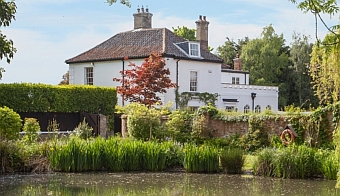 The White House, Somerleyton
The White House, Somerleyton
Berry F.Berry (1852-1926)
Berry's father gave all his six children - male and female - the first name Berry. These were probably the first cases of beriberi which were not caused by a vitamin deficiency. Berry F. Berry added to the confusion by giving his own son the first name Berry.
The 1881 census shows Berry living in Newton Grove, but he soon moved to North London and taught art at The Berry F. Berry Art School, 86 Fellow's Road, Swiss Cottage. By 1893 he seems to have given up art and turned to drink - he started a career in the wine trade.
There isn't much by him on the net but this is one of his illustrations from the book "Comic Insects" by F. A. S. Reid.
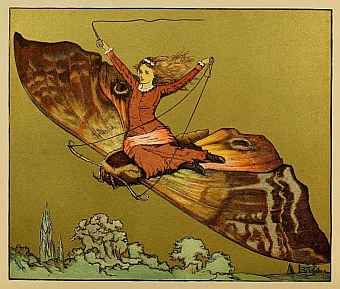 Comic Insects illustration by Berry Francis Berry 1872
Comic Insects illustration by Berry Francis Berry 1872
Thomas Erat Harrison (1858-1917)
Harrison's specialism was bookplates. Even in his own time this was a fairly arcane interest, but he was born into a wealthy family and he had no need to paint for money and this is probably why he produced so little apart from some stained glass designs and a book on ornamental design.
The Bedford Park book was published by his family's firm. Harrison and Sons printed bank notes and government papers for hundreds of years. A book about the firm contains the following quote :
Statesmanship is like vine-growing, the making of bank-note paper, the cultivation of rice, or the printing of the documents of the Foreign Office ; the work is done better when successive generations devote themselves to the work.
Harrison's father, like many Harrisons before him, had held high office in the Stationers' Company, a City of London livery company. Anyone who has wandered around the City of London would have noticed the expensive and exclusive looking buildings belonging to the livery companies. I don't think anyone really knows what these livery companies do, unless you belong to one of them, but the Stationers' Company must be doing something useful because it has been going since 1406.
Nine generations of Harrisons working for Harrison and Sons ended when the firm was taken over by Lonrho in 1979. Tiny Rowland had little time for tradition. I was looking at some online photos of the now abandoned Harrison and Sons factory in High Wycombe when I noticed this photo. I don't know what it is but I know it would have interested Thomas Erat Harrison. His book on ornamentation is mostly about scrolls. How felicitous that almost the only thing left in the deserted factory from the House of Harrison should be that object with the attractive scroll.
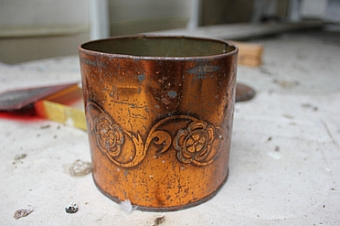 A picture taken in the abandoned Harrison and Sons factory in 2011.
A picture taken in the abandoned Harrison and Sons factory in 2011.
Edward Hargitt (1835 – 1895)
Hargitt was known for his pastoral landscapes. When he wasn't painting cattle he was often found climbing trees to steal bird eggs. His obituary said his collection of birds eggs was "one of the finest in existence".
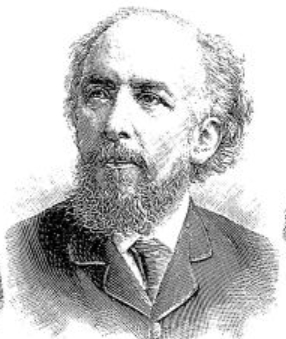
Edward Hargitt (1835 – 1895)
He lived at 1 Bedford Road.
Frederick Hamilton Jackson (1848-1923)
Jackson lived at 18 Queen Anne's Grove. I think his painting below shows 22 Queen Anne's Grove. When Jackson lived at number 18 the plots between 18 and what is now 22 had not been built on.
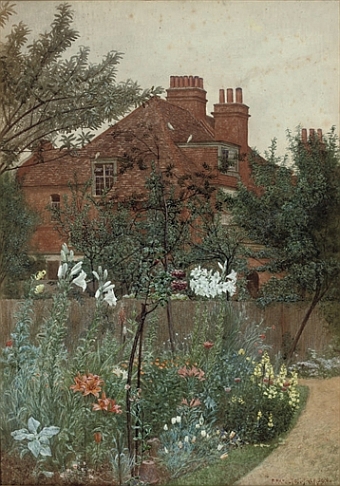
View of a garden in Bedford Park by F. Hamilton Jackson
Thomas Matthews Rooke (1842-1942)
Rooke lived in the house below for more than 60 years. This house is also shown as picture 4 on the left. Rooke worked for Ruskin, William Morris and Edward Burne-Jones. He was a highly regarded painter. His son Noel Rooke was also a noted artist.
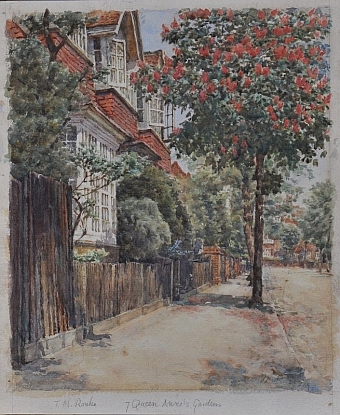
7 Queen Anne Gardens by Thomas Matthews Rooke (1842-1942)
Henry Marriott Paget (1856–1936)
H.M. Paget was known for his magazine illustrations, but he was overshadowed by his brother Sidney who created the famous Sherlock Holmes illustrations for The Strand Magazine.
H.M.Paget's obituary stated that "he was never happier than when boating or swimming". That is a very strange statement when you consider that Paget lost his sister in a boating accident. On the 22nd of August 1891 two of Paget's sisters, another woman, a young girl and a 20 year old boat man were tipping into the sea off South Hayling Beach when their rowing boat suddenly sank. Paget and his brother, Arthur Paget, witnessed this and jumped into the sea to attempt a rescue. They saved three but his 27 year old sister Eleanor Paget drowned with the boat man. She lived at Bedford Gardens.
He was an army officer in the First World War and in 1916 at the age of 60 he was mentioned in dispatches.